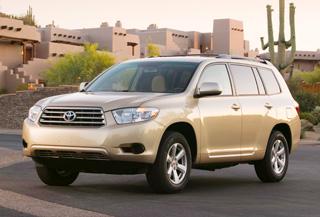
DEARBORN, MI – All auto makers communicate with their customers to learn their likes and dislikes.
Toyota Motor Corp. took that a step further by also picking the brains of consumers who shopped for its midsize Highlander cross/utility vehicle, but ended up buying a competitor’s offering.
Toyota wanted to know what the problem was.
“Customers who rejected the Highlander told us they needed to be inspired by their SUV,” says Brian Smith, Toyota Motor Sales U.S.A. Inc.’s corporate marketing manager-truck operations.
And although some auto industry observers predict a downsizing of vehicle dimensions and a lessening of horsepower, surveyed consumers told Toyota the Highlander needed more room and more power.
That’s what they get with the redesigned ’08 Highlander. It is nearly 4 ins. (10 cm) longer, 3 ins. (8 cm) wider and 400 lbs (181 kg) heavier than its predecessor.
The new Highlander is powered by a 3.5L V-6 that delivers 270 hp, a 55 hp increase over the previous-generation model.

“People wanted more power and that was addressed,” Smith says at a press preview here.
He doesn’t see that as being irreconcilable with calls in some circles – including the U.S. Congress – for greater fuel efficiency.
Americans still want that, Smith says. “Interest in fuel economy is getting on the top 10 list of what car shoppers want. It didn’t used to be there.”
Wanting more power doesn’t mean wanting less fuel economy, he says. “It is a challenge to engineers to design more powerful engines that still have good fuel economy.”
Accordingly, the new Highlander shows slightly better numbers: for the 2-wheel drive model, 18/24 mpg (13/9.8L/100 km) compared with 17/23 mpg (13.8/10.2L/100 km) for the previous generation; for the 4-wheel drive model, 17/23 mpg (13.8/10.2L/100 km) compared with 16/22 mpg (14.7/10.7L/100 km) for the predecessor.
The hybrid-electric version’s fuel economy remains the same at 27/25 mpg (8.7/9.4L/100 km).
Since debuting in 2001, the Highlander has sold nearly 800,000 units. Sales slipped from 137,409 in 2005 to 129,794 in 2006, but were up 7% in the first half of this year, according to Ward’s data.
Toyota hopes to sell 138,000 Highlanders in calendar 2008.
Smith says the new model “raises the bar in every metric of comparison,” including added safety features such as seven standard air bags and active headrests.
Exterior designers sought to give the vehicle a stronger, more refined look with features such as angular fender shapes, a trapezoid grille and shoulders accentuating body volume.
“On the outside, Highlander moves away from traditional SUV styling cues of tough and rugged to a look and feel that is intelligent and advanced,” Smith says.
The CUV segment in which the Highlander competes (against the likes of the Honda Pilot, Nissan Murano, Saturn Vue and Ford Escape) is getting more crowded.
Smith notes that 10 new CUV nameplates were introduced since the launch of the first-generation Highlander six years ago. “And we’ll see five more new entries this year, alone.”
Along with size, weight and power, the Highlander has increased in another respect: price.
The $27,300 base-model sticker is $500 more than the previous model. The Limited 4X4 carries a $34,150 manufacturer’s suggested retail price that’s $1,940 higher than before.




